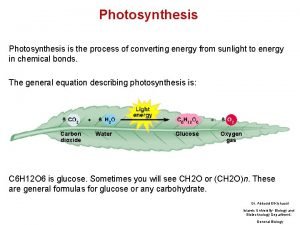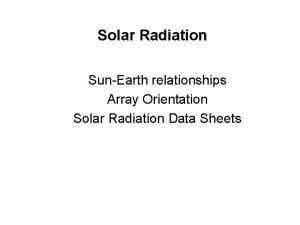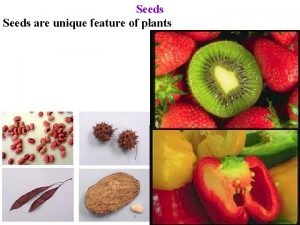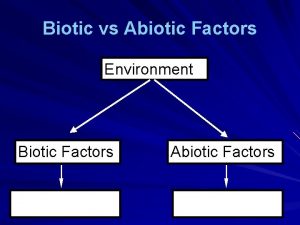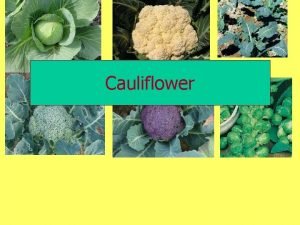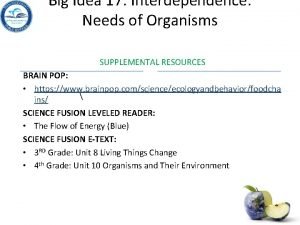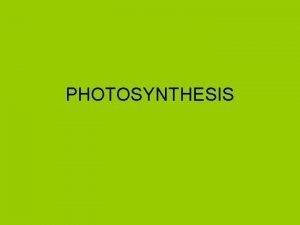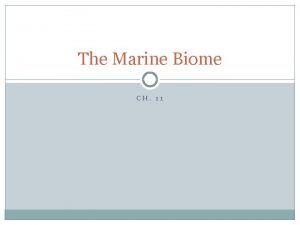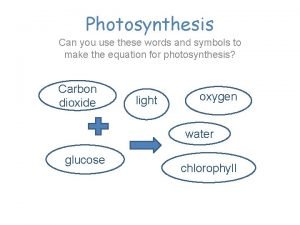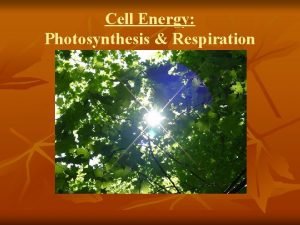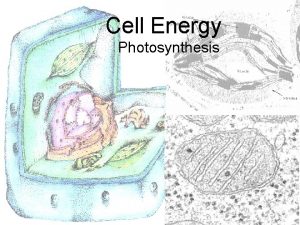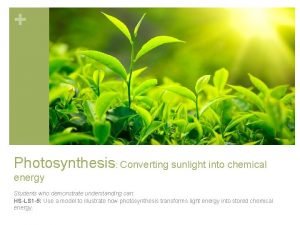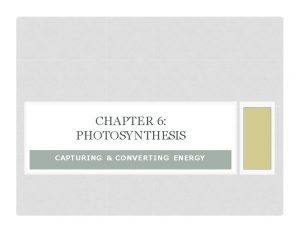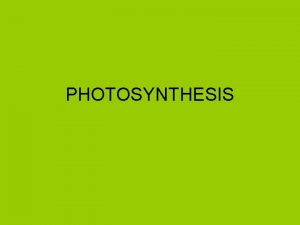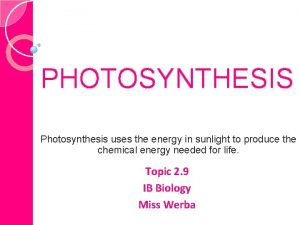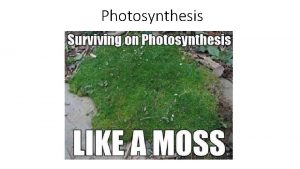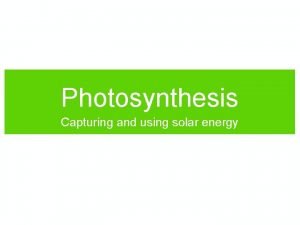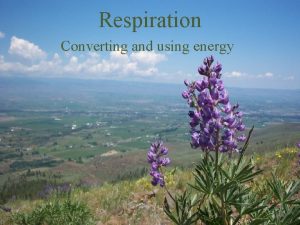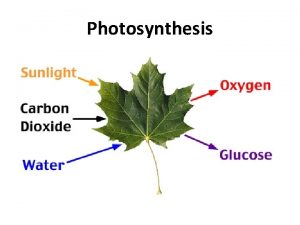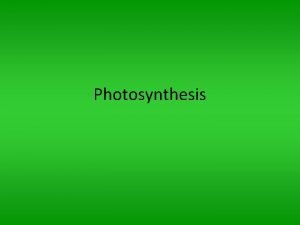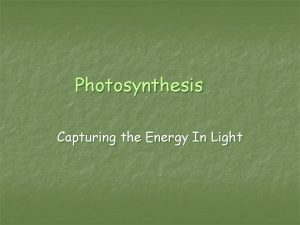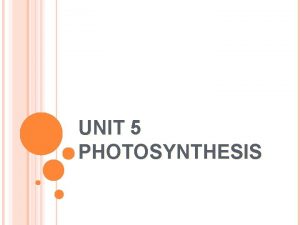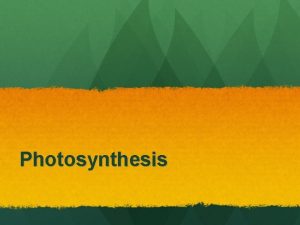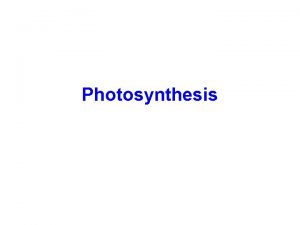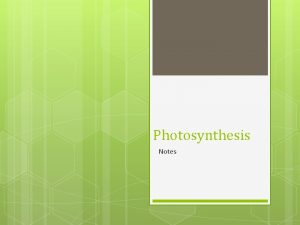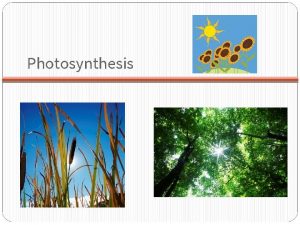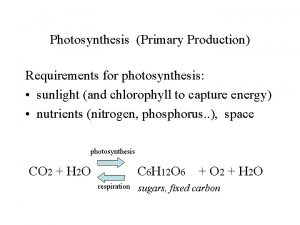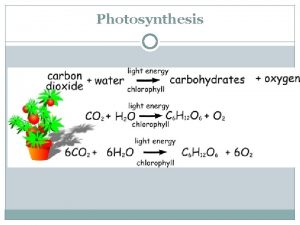Photosynthesis Capturing and Converting Sunlight Energy Photosynthesis Equation





































- Slides: 37

Photosynthesis Capturing and Converting Sunlight Energy

Photosynthesis: - Equation - Structures & Molecules Involved

Cellular Energy: Photosynthesis Slide #2 Photosynthesis Chemical Equation light 6 CO 2 + 6 H 2 O C 6 H 12 O 6 + 6 O 2

Cellular Energy: Photosynthesis Slide #3 Photosynthesis Chemical Equation with presence of light, plants transform carbon dioxide (CO 2) & water (H 2 O) into carbohydrates (C 6 H 12 O 6) & release oxygen (O 2) light 6 CO 2 + 6 H 20 C 6 H 12 O 6 + 6 O 2

Cellular Energy: Photosynthesis Slide #4 Photosynthesis Chemical Equation light 6 CO 2 + 6 H 2 O C 6 H 12 O 6 + 6 O 2 Requirements: • CO 2 – carbon dioxide is absorbed from air • H 2 O – water absorbed from environment • energy – energy from sun trapped by chlorophyll in chloroplasts Products/Wastes: • C 6 H 12 O 6 – organic sugar stored in plant • O 2 – oxygen is released as a waste product

Cellular Energy: Photosynthesis Slide #5 Photosynthesis Chemical Equation light 6 CO 2 + 6 H 2 O C 6 H 12 O 6 + 6 O 2 glucose (sugar) ß What type of macromolecule is this?

Cellular Energy: Photosynthesis Molecular Structure of Glucose 6

Cellular Energy: Photosynthesis Types of Organisms That Perform Photosynthesis: algae (either unicellular or multicellular) can absorb necessary materials for autotrophic nutrition directly through its cell membrane MOST photosynthetic reactions occur from algae in the world's oceans in complex, terrestrial (land) plants, happens in leaves Slide #7

Cellular Energy: Photosynthesis Slide #8

Cellular Energy: Photosynthesis Slide #9 Plant Structures Involved in Photosynthesis Leaf - broad, flat structure that allows a lot of light (red & blue wavelengths are most effective - green is least effective) to be absorbed at once allows gases like CO 2 & O 2 to pass through

Cellular Energy: Photosynthesis Slide #10

Cellular Energy: Photosynthesis Slide #11 Plant Structures Involved in Photosynthesis cross-section of a leaf

Cellular Energy: Photosynthesis Plant Structures Involved in Photosynthesis: cuticle - waxy coating that covers top of leaf 3 functions: protects the inside of a leaf prevents excess water loss helps resist invasion by fungi upper epidermis - outer layer of cells; leaf have an upper epidermis & a lower epidermis Slide #12

Cellular Energy: Photosynthesis Plant Structures Involved in Photosynthesis: Slide #13

Cellular Energy: Photosynthesis Plant Structures Involved in Photosynthesis: Slide #14

Cellular Energy: Photosynthesis Plant Structures Involved in Photosynthesis: palisade layer - place in leaf where most photosynthesis takes place P for photosynthesis P for palisade layer spongy layer - layer of leaf where gases (mostly CO 2 & O 2) circulate; some photosynthesis happens here Slide #15

Cellular Energy: Photosynthesis Plant Structures Involved in Photosynthesis: Stomata stomata - pore-like opening on bottom of plant leaf allows CO 2 to diffuse in or O 2 to diffuse Slide #16

Cellular Energy: Photosynthesis Plant Structures Involved in Photosynthesis: stomata - openings in lower epidermis; allows exchange of O 2, CO 2, & H 2 O between internal (inside) & external (outside) environments size of opening is controlled by the. . . guard cells – control opening of stomata; have few chloroplast to use to obtain energy to open & close Slide #17

Cellular Energy: Photosynthesis Plant Structures Involved in Photosynthesis: veins - larger tubes that carry materials 2 types: xylem - carry water & materials up phloem - carry food down Slide #18

Cellular Energy: Photosynthesis Slide #19 Plant Structures Involved in Photosynthesis

Cellular Energy: Photosynthesis Plant Structures Involved in Photosynthesis: Chloroplast Organelle photosynthesis Slide #20 takes place inside chloroplasts

Cellular Energy: Photosynthesis Plant Structures Involved in Photosynthesis: Chloroplast Organelle photosynthesis Slide #21 takes place inside chloroplasts

Cellular Energy: Photosynthesis Plant Structures Involved in Photosynthesis: Chloroplast Organelle Slide #22

Cellular Energy: Photosynthesis Plant Structures Involved in Photosynthesis: Chloroplast Organelle parts of chloroplast thylakoid - saclike photosynthetic membrane containing chlorophyll & other pigments granum - stack of thylakoids stroma - region (space) outside thylakoids Slide #23

Cellular Energy: Photosynthesis Plant Structures Involved in Photosynthesis: Chloroplast Organelle parts of chloroplast thylakoid - saclike photosynthetic membrane containing chlorophyll & other pigments granum - stack of thylakoids stroma - region (space) outside thylakoids Slide #24

Transmission electron microscope image of a chloroplast. Cellular Energy: Photosynthesis Grana Slide #25 of thylakoids and their connecting lamellae are clearly visible

Cellular Energy: Photosynthesis Molecules Involved in Photosynthesis: pigments in Chloroplast Organelle pigment – colored substance that absorbs or reflects light different pigments absorb different wavelengths of light photons of light “excite” electrons in plant’s pigments excited electrons move to HIGHER energy levels & carry the absorbed energy Slide #26

Cellular Energy: Photosynthesis Molecules Involved in Photosynthesis: pigments in Chloroplast Organelle chlorophyll – principal pigment in cells of photosynthetic autotrophs that captures light energy absorbs red & blue light reflects green Slide #27 absorption of light by chlorophyll a & chlorophyll b

Cellular Energy: Photosynthesis 28 Molecules Involved in Photosynthesis: Chlorophyll Pigments Chlorophyll a • found in all plants, algae, & cyanobacteria • makes photosynthesis possible Chlorophyll b • accessory pigment • acts indirectly in photosynthesis by transferring light it absorbs to chlorophyll a 28

Cellular Energy: Photosynthesis What is Needed for Photosynthesis to Occur? Energy Storing Pigments green plant absorbs sunlight, energy of sunlight is transferred to electrons in chlorophyll pigment, raising them to a higher energy level these high energy electrons are trapped in chemical bonds Slide #29

Cellular Energy: Photosynthesis two ways high energy electrons are trapped in chemical bonds: 1. pair of high energy electrons passed directly to an electron carrier (molecule can accept a pair of high energy electrons & later transfer them along with most of their energy to another compound) NADP+ - electron carrier that is converted to NADPH 2. when it accepts pair of high energy electrons production of ATP adenosine triphosphate (ATP) – energy storing compound that consists of adenine, a 5 -carbon sugar called ribose, & 3 phosphate groups Slide #30

Cellular Energy: Photosynthesis 31 What is Needed for Photosynthesis to Occur? ATP (adenosine triphosphate) nucleic acid molecule of energy (how we store energy from foods we eat)

Cellular Energy: Photosynthesis What is Needed for Photosynthesis to Occur? Adenosine Diphosphate adenosine diphosphate (ADP) – ATP releases energy, a free phosphate, & ADP when cells take energy from ATP *1 phosphate bond has been removed Slide #32

Cellular Energy: Photosynthesis Light Dependent Reaction Slide #33

Cellular Energy: Photosynthesis ATP & NADPH high energy molecules that only store energy temporarily adenosine triphosphate (ATP) nicotinamide adenine dinucleotide phosphate (NADPH) Slide #34

Cellular Energy: Photosynthesis ATP Glucose short term storage of long term storage of energy; breaks down energy; can hold 90 x to ADP & loses energy more energy than ATP. transfers energy very takes longer to get quickly energy out Slide #35

Cellular Energy: Photosynthesis What is Needed for Photosynthesis to Occur? ATP (adenosine triphosphate) 36
 Photosynthesis is the process of converting
Photosynthesis is the process of converting Photosynthesis transforms light energy into chemical energy
Photosynthesis transforms light energy into chemical energy Raindrops sunlight and refraction lyrics
Raindrops sunlight and refraction lyrics Energy energy transfer and general energy analysis
Energy energy transfer and general energy analysis Energy energy transfer and general energy analysis
Energy energy transfer and general energy analysis Pricing understanding and capturing customer value
Pricing understanding and capturing customer value Creating and capturing customer value
Creating and capturing customer value Creating and capturing customer value
Creating and capturing customer value Core customer and marketplace concepts
Core customer and marketplace concepts Creating and capturing value
Creating and capturing value Earth's revolution
Earth's revolution Inertia vs gravity
Inertia vs gravity Hours of sunlight map
Hours of sunlight map Seed maturation
Seed maturation Product development life cycle methodology
Product development life cycle methodology Abiotic enviorment
Abiotic enviorment Direct sunlight lux
Direct sunlight lux How does heat move
How does heat move Value added products of cauliflower
Value added products of cauliflower Poem beauty
Poem beauty Hawk us
Hawk us Which object converts sunlight into sugars?
Which object converts sunlight into sugars? Oceanic divisions
Oceanic divisions How much sunlight does the marine biome get
How much sunlight does the marine biome get Are trees biotic factors
Are trees biotic factors Formula for cellular respiration
Formula for cellular respiration Reaction for cellular respiration
Reaction for cellular respiration Photosynthesis in symbols
Photosynthesis in symbols A percent is a fraction whose denominator is 100
A percent is a fraction whose denominator is 100 Converting between percents decimals and fractions
Converting between percents decimals and fractions How do plants get glucose
How do plants get glucose Capturing kids hearts four questions
Capturing kids hearts four questions Forecasting and demand measurement in marketing
Forecasting and demand measurement in marketing Measuring sources of brand equity
Measuring sources of brand equity Excel capturing kids hearts
Excel capturing kids hearts Input devices images
Input devices images Capturing reality documentary
Capturing reality documentary Qualitative research techniques to measure brand equity
Qualitative research techniques to measure brand equity
